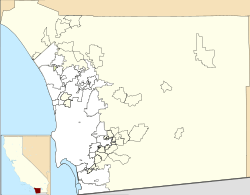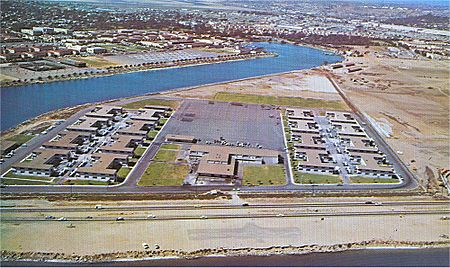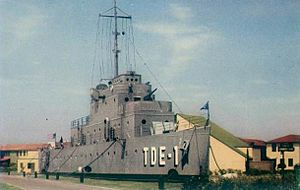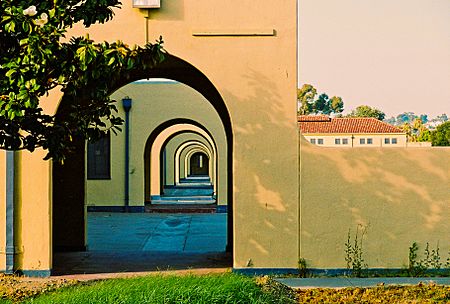Naval Training Center San Diego facts for kids
Quick facts for kids Naval Training Center San Diego
|
|
|---|---|
| San Diego, California | |
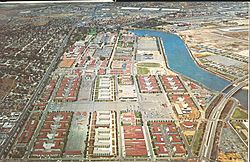
Early 1970s view of the Naval Training Center.
|
|
| Coordinates | 32°44′8″N 117°12′44″W / 32.73556°N 117.21222°W |
| Type | Naval Base |
| Site information | |
| Controlled by | United States Navy |
| Site history | |
| Built | 1923 |
| In use | 1923–1997 |
|
Naval Training Station
|
|
| Location | Barnett St. and Rosecrans Blvd., San Diego |
| Area | 550 acres (220 ha) |
| Built | 1922 |
| Architect | Naval Public Works Center Frank Walter Stevenson |
| Architectural style | Mission/Spanish Revival |
| NRHP reference No. | 00000426 |
| Added to NRHP | July 5, 2001 |

The Naval Training Center San Diego (NTC San Diego) was a big training base for the United States Navy in San Diego, California. It was open from 1923 to 1997. This base was located at the north end of San Diego Bay.
Today, the area where NTC San Diego once stood is a historic site. Many of its buildings are protected because of their history. The base closed in 1997 after the Cold War ended. Now, it's a cool place called Liberty Station. It has shops, restaurants, and parks, all built by the City of San Diego.
Contents
How the Base Started
In the 1920s, the city of San Diego wanted to work more closely with the military. They offered the Navy over 200 acres of land in Point Loma. This was to convince the Navy to move its recruit training from San Francisco to San Diego.
A congressman named William Kettner was key in getting this base built. Congress approved the idea in 1919. Construction began in 1921, and the base officially opened in 1923. Captain David F. Sellers was its first leader.
Building and Growing the Base
For 70 years, the main goal of NTC San Diego was to train sailors. They taught new recruits and offered advanced courses for experienced Navy members. To do this, the base grew a lot. It ended up with 300 buildings and almost three million square feet of space.
The first buildings were designed in a style called Mission Revival. They were placed along two main lines. Over time, the harbor was improved, and more land was added to the base. NTC San Diego eventually grew to almost 550 acres.
NTC During Wartime
During World War II, the base was very busy. It housed up to 33,000 men, with 25,000 of them being new recruits. After the war, the number of people on base dropped.
However, during the Korean War, the base became super crowded again. It had a peak of 40,000 people. In 1952, money was approved to turn some barracks into classrooms. They also built a new camp for recruits called Camp Nimitz.
Camp Nimitz was finished in 1955. It had 16 barracks for over 3,200 sailors. There was also a huge dining hall that could feed 5,000 sailors at once.
In the mid-1960s, during the Vietnam War, even more trained sailors were needed. The number of recruits at NTC surged to over 18,000. New dining facilities and classrooms were built. By 1970, many upgrades and new buildings were completed.
By the early 1990s, San Diego was a major Navy city. More than one-sixth of the Navy's entire fleet was based there. The military was a huge part of San Diego's economy.
How the Base Helped San Diego
NTC San Diego brought a lot of money to the local economy. The yearly payroll for military and civilian staff was almost $80 million. This was based on the Navy's 1994 budget.
Each year, over 28,000 visitors came to NTC for graduation ceremonies. Most of these visitors were from out of town. They spent almost $7 million annually in San Diego. The Navy also spent another $10 million on base operations.
Special Features of the Base
One unique thing at the base is the "non-ship" called the USS Recruit. It's a concrete structure built into the ground. It's two-thirds the size of a real warship.
Built in 1949, it was used to teach new recruits how to act on a ship. It was nicknamed the USS Neversail because it never actually sailed. Today, the Recruit is empty and is part of Liberty Station. People have suggested turning it into a museum.
There's also a 9-hole golf course called Sail Ho Golf Course. It was built in the 1920s for people on the base. Now, it's open to the public. A famous golfer named Sam Snead even managed the course for a while. A unique feature of the course is two graves between fairways, where a former commander and his wife are buried.
Closing the Base
After the Cold War ended, the military needed to reduce its size. In 1993, a special commission decided that NTC should close. Since 1994, RTC Great Lakes in Illinois has been the Navy's only basic training facility.
The Navy closed NTC in stages. As military activities decreased, the Navy's budget for the base also went down. To prevent security problems, the City of San Diego and the Navy made an agreement in 1995. This allowed the city to use parts of the base temporarily.
The city then rented out buildings to film companies, non-profit groups, and small businesses. This helped keep the buildings and grounds in good shape. The Navy officially closed NTC on April 30, 1997. All military operations stopped then.
A small part of the base was kept by the military. It is now controlled by Naval Base Point Loma. This area still has a medical clinic, a small Navy store, and a gas station. Also, 500 new military homes were built there.
Images for kids
See also
 In Spanish: Centro de Entrenamiento Naval de San Diego para niños
In Spanish: Centro de Entrenamiento Naval de San Diego para niños




